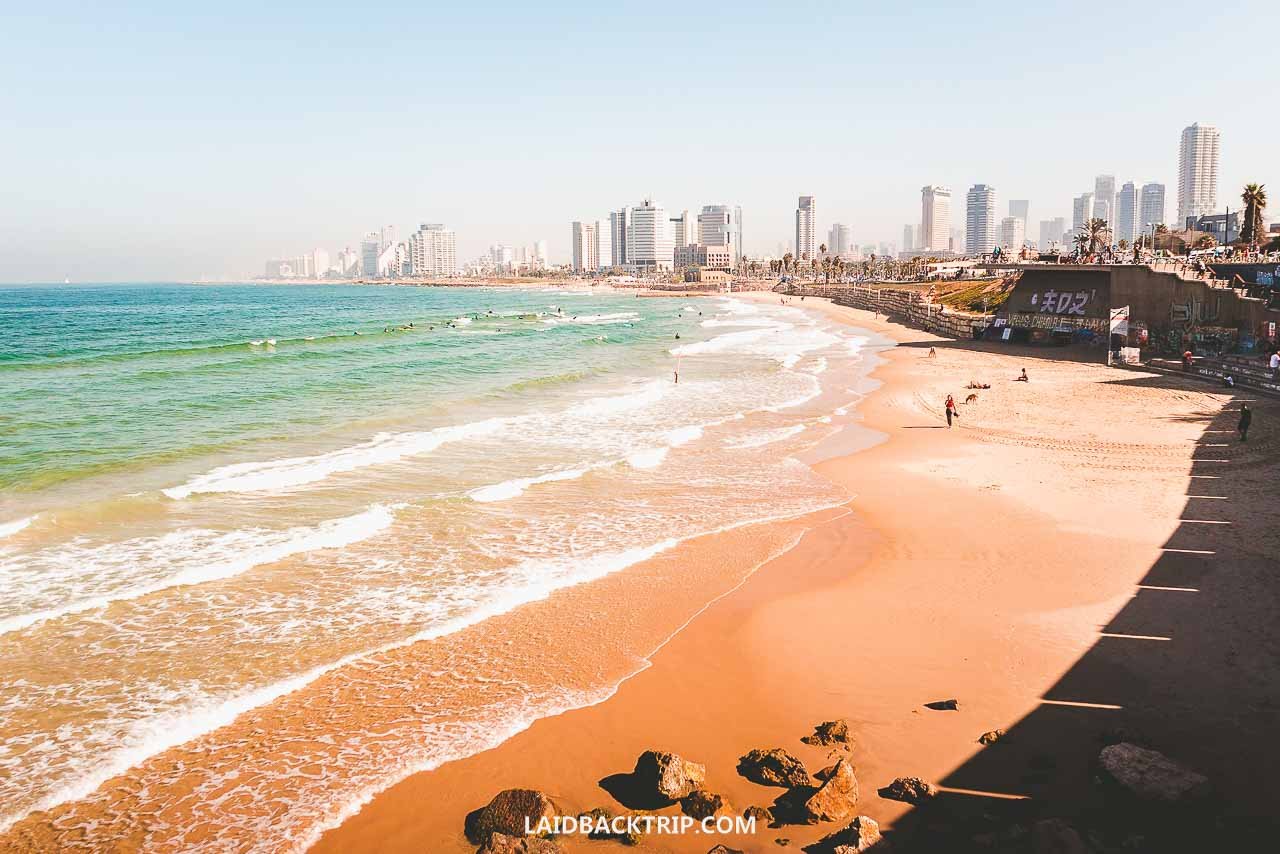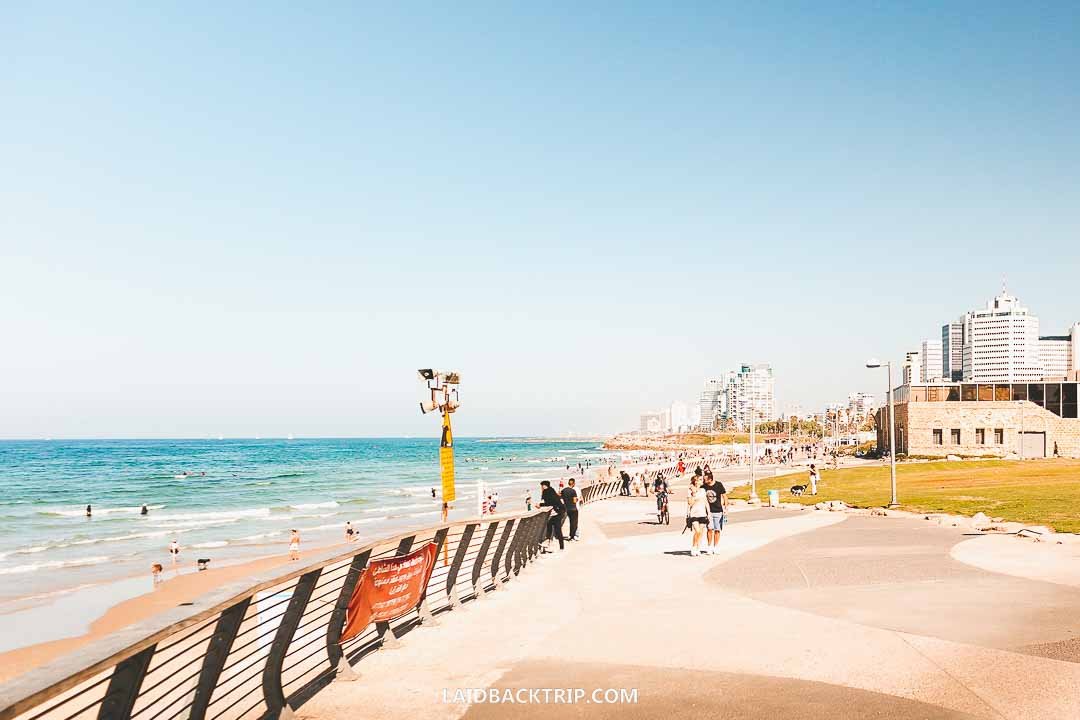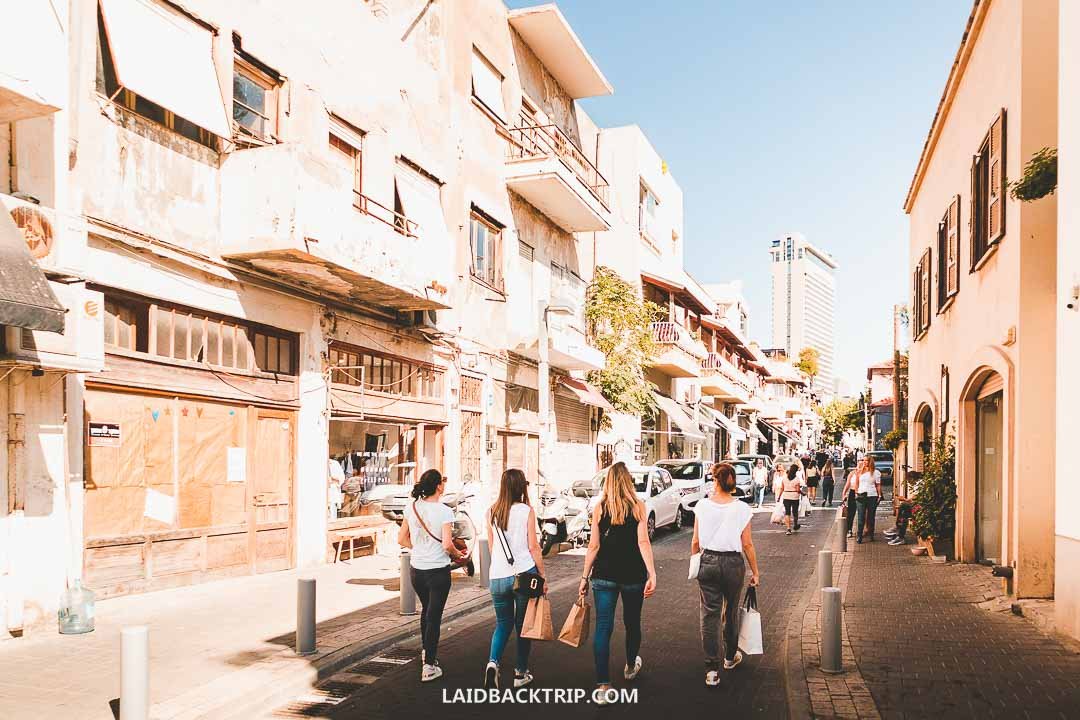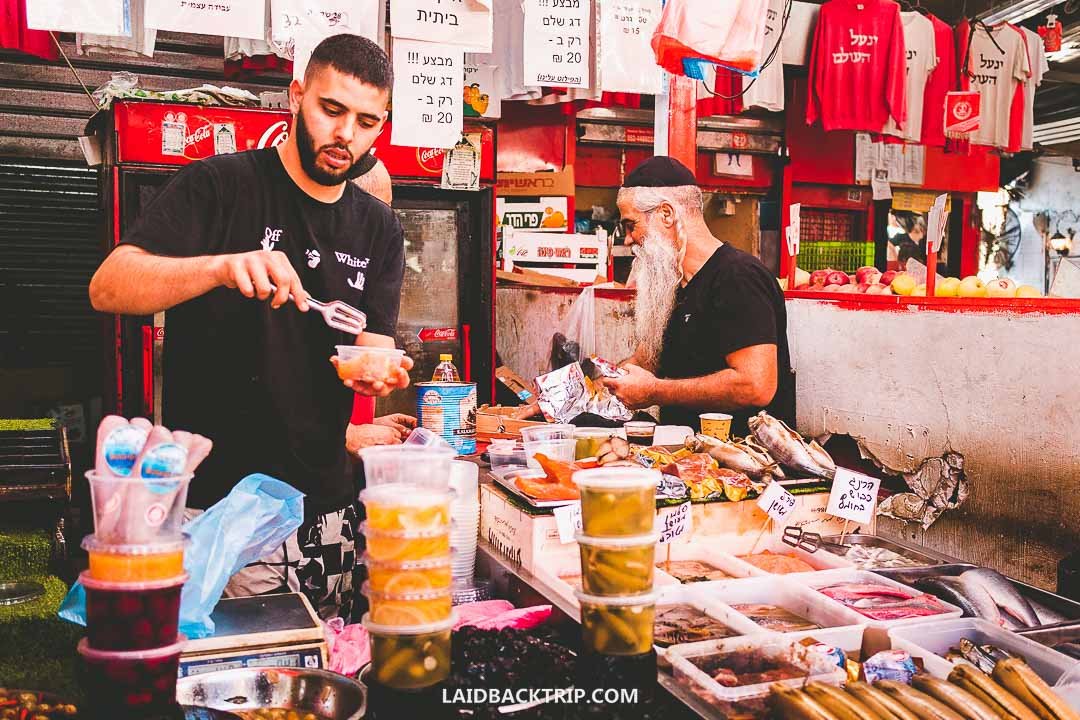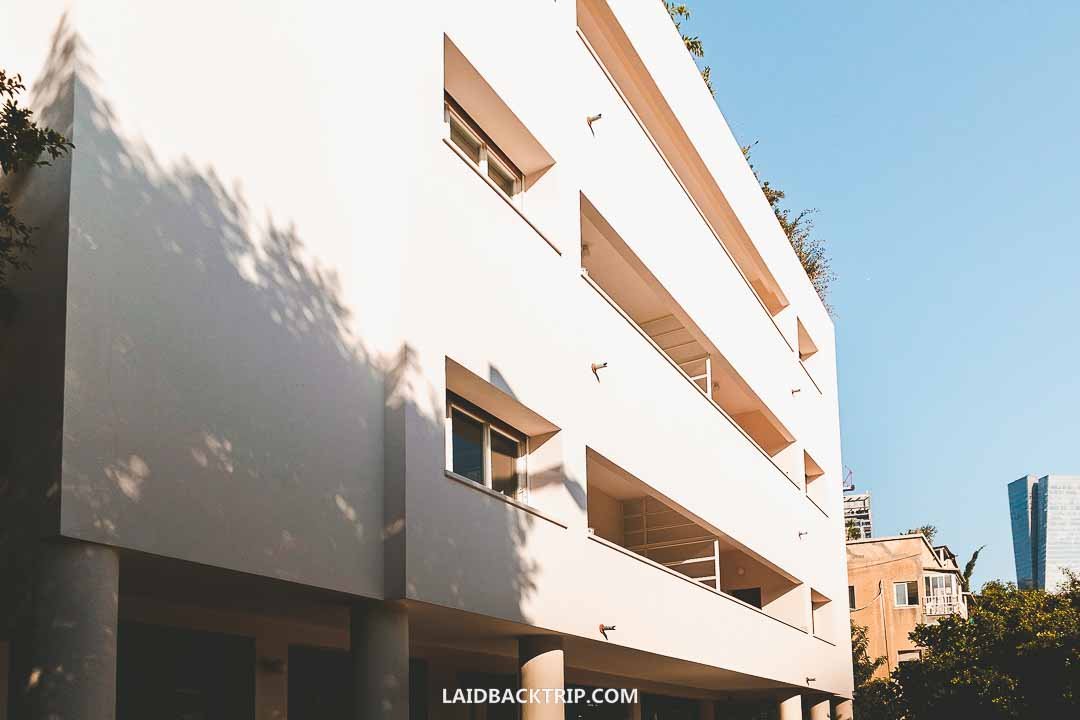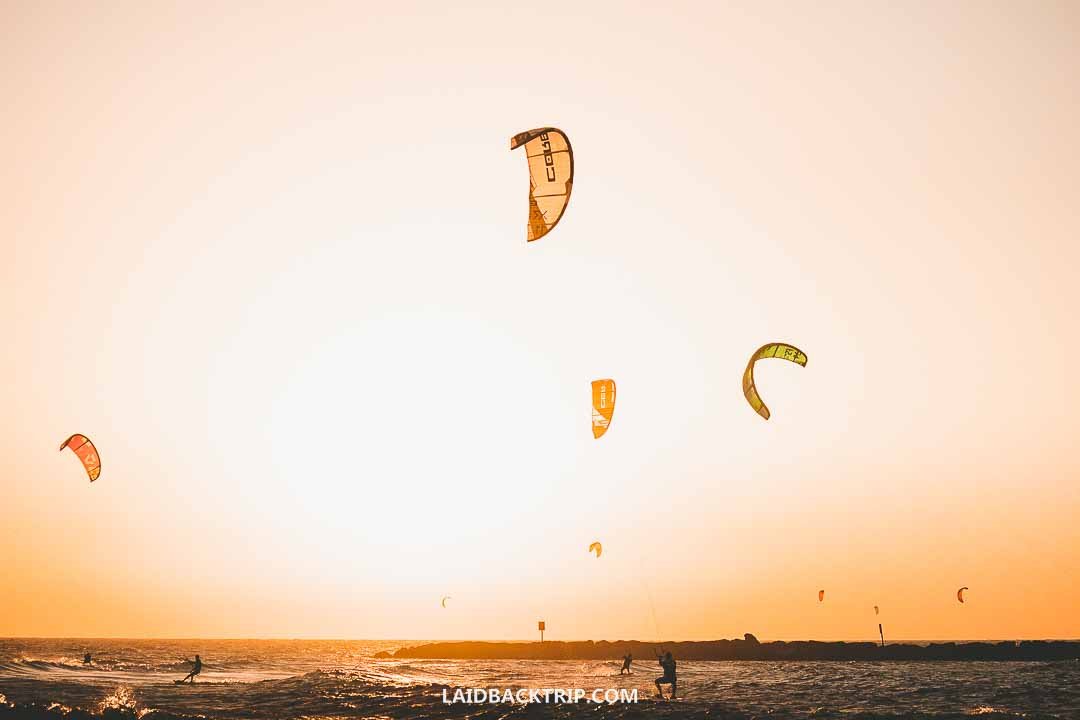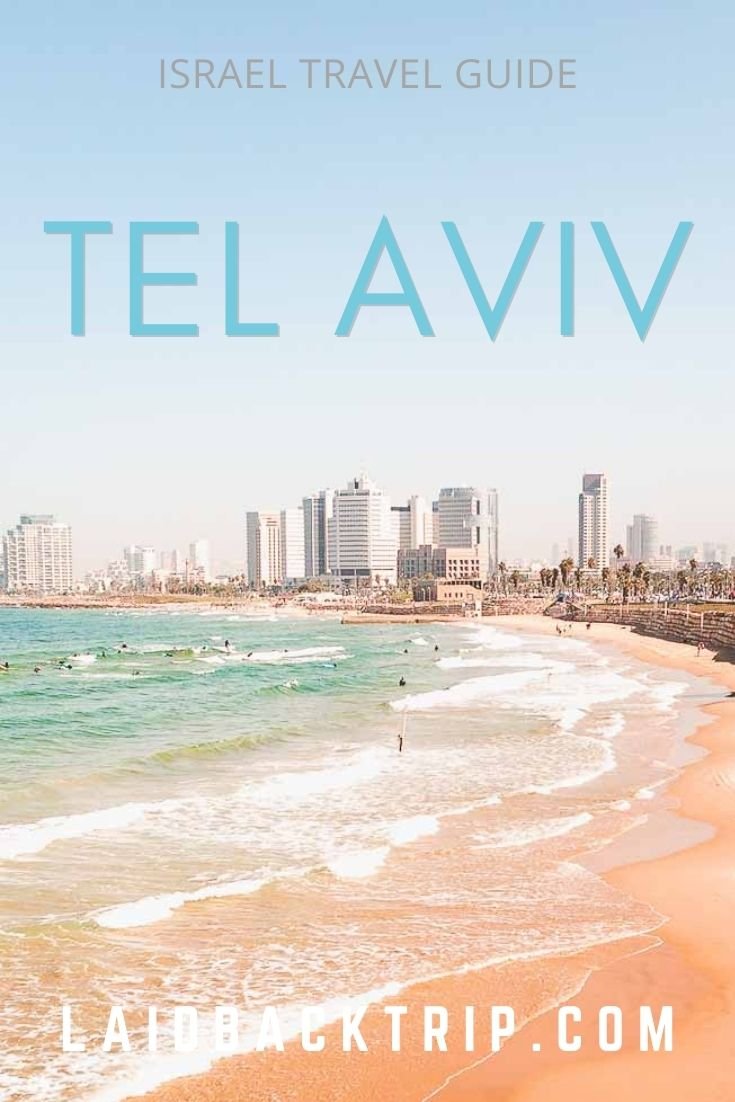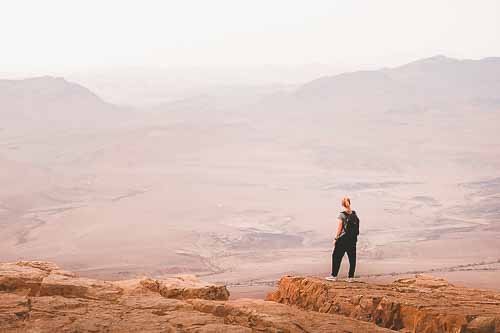A Complete Guide to Tel Aviv
Read our travel guide on Tel Aviv (TLV) in Israel for first-time travelers. Includes best things to do and see, tips on where to stay, how to get, or when to go.
Also known as the White City, Tel Aviv in Israel was one of the most captivating places we've ever visited.
The city is known for its excellent cuisine, golden-sand beaches, fascinating culture, cosmopolitan vibes, and famed nightlife.
Due to its energetic heart that never stops beating, Tel Aviv is a must-visit place for all types of travelers.
The sensation that runs through the city's air is hard to describe. It has to do something with the fact that Tel Aviv receives over three hundred sunny days a year, and the city has some really cool beaches.
Yes, the beach life is a vital part of Tel Aviv's essence, and it looks like the locals really can take advantage of it and know how to seize the day.
At the end of a long day, while chilling on the beach, we both agreed that the first impression of Tel Aviv was simply great.
And honestly, I can't think of many places around the world that would have such a huge impact on our first impression.
Simply put, Tel Aviv is one of those places that make you want to stay here longer, for a few more days or even weeks.
And despite its reputation of being one of the most expensive cities in the world, we still believe that you can visit Tel Aviv on a budget. Well, sort of, but more about it later.
So here's everything you should know before visiting Tel Aviv before you go.
History
Tel Aviv is a young and modern city that was founded in 1909 by gathering 66 Jewish families on the beach and using the lottery system to parcel out the land.
However, the history of Jaffa dates back to ancient times.
The old port on the Mediterranean coast had seen the rule of Canaanites, Phoenicians, Romans, Crusaders, Ayyubids, Ottomans, and many more.
Fast forward to modern times, Neve Tzedek was the first Tel Aviv neighborhood.
Later on, Tel Aviv absorbed the historic port of Jaffa. Today, you can often see the name Tel Aviv-Yafo, which is, in fact, the city's full name.
The set of similar-looking buildings known as the White City was built in the 1930s, and today it's a UNESCO World Heritage Site.
The construction of the high-rise buildings and skyscrapers began in the 1960s, changing the appearance of Tel Aviv for good.
The history of Tel Aviv is far more intriguing, and we hope you will have time to learn more about the city yourself.
How to Visit Tel Aviv on a Budget
So is Tel Aviv really that expensive for travelers? Yes, Tel Aviv is not the best travel destination for backpackers and budget travelers.
Still, there are always ways to cut down your travel expenses.
The main expense on your trip will be the accommodation. There is no way around it.
Even the basic bed in a dormitory will not be cheap, so you should plan your travel dates carefully.
On the other hand, there are plenty of free things to do in Tel Aviv, which will help you even out your budget.
As the city is not that large, you can save on transportation as it's easy to get almost anywhere on foot.
Also, try to avoid the beach cafes or restaurants as they are often very pricey due to their exquisite location.
For more information on this topic, make sure to read our guide on visiting Israel on a budget.
What to See and Do
Even though Tel Aviv is often described as a city with incredible nightlife, we have to say that the city doesn't sleep during the day as well.
There are plenty of things to do in Tel Aviv even before dusk, so don't be afraid of getting bored if the nightlife is not your thing.
Jaffa
Right from the start, we have to clarify that Tel Aviv can't compete with Jerusalem in terms of ancient attractions.
Still, even in this modern city, you can find the picturesque albeit small historical center.
Jaffa has been home to Arabs and Jews for centuries, making it a fascinating blend of cultures and architecture.
In fact, Jaffa is considered to be one of the oldest ports in the world, as its history reaches back to ancient times.
Yes, one of the most important things to know before visiting Israel is that the ancient history is on every corner, even in the modern cities.
Built on a hill overlooking the Mediterranean Sea, Jaffa is home to narrow streets and passages, cobblestone alleyways, fascinating stores and art galleries, and Ottoman-era attractions such as the Clock Tower and St. Peter's Church, and many old houses.
Simply put, Jaffa is a perfect place to get lost in a maze of nostalgia, architecture, and history.
If you're a fan of similar places, make sure to also visit the old port area in Akko.
Another popular stop near the Jaffa's church is the Wishing Bridge with the zodiac signs, at least if you're waiting for some of your wishes to be fulfilled.
There is also Ramses Gate, with a small archaeological site nearby.
A fascinating suspended Orange Tree or a lovely Smiling Whale is only a short walk from here.
And if you still have some time to kill, consider visiting the popular flea market in Jaffa.
Don't forget to haggle down the price and bring cash.
Once you're ready to leave the old part, walk back via the promenade to Tel Aviv's modern neighborhoods.
The views of the city skyline, Mediterranean Sea, and sandy beaches are amazing.
It also works vice versa, but the modern buildings will be replaced with the old port dominated by the St. Peter's Church.
Jaffa and Tel Aviv Tour
If you're short on time or want to learn more about the city, you can discover Tel Aviv and Jaffa's art, history, culture, and food on a guided tour.
Here you can reserve a popular Tel Aviv City Tour with a local guide.
Beaches
Tel Aviv has thirteen beaches, and we have a feeling that everyone will have a chance to find their favorite beach.
The coastal strip that stretches from Herzliya to Bat Yam is fourteen kilometers long and features some top beaches such as Gordon, Hilton, Jerusalem, and Bograshov Beach.
You would need at least a few days to fully explore Tel Aviv's beaches, but the central ones are very nice and more than satisfactory.
Simply put, if you like city beaches, the golden sandy stripes that line the city won't disappoint you.
The local beaches have not only sandy characteristics but also feature free outdoor gyms, volleyball courts, playgrounds, changing rooms, ice-cream vendors, beach bars, chair rentals, and lifeguards.
By the way, the beaches in Tel Aviv face west, so be prepared to arrive there just before the sunset.
Watching the sun setting behind the horizon of the Mediterranean Sea while sitting on a beach was definitely one of the best experiences we had in Tel Aviv.
The best part about Tel Aviv's beaches is that while some parts might be crowded at times, you will always be able to find a place with only a few people around you.
Don't forget that the beaches in Tel Aviv are free, which is really great if you're visiting Israel on a budget.
There are also three very distinctive beaches in Tel Aviv sitting right next to each other.
Hilton Beach is LGBTQ-friendly, Nordau Beach is a gender-segregated beach for religious people, and Dog Beach is obviously a dog-friendly beach.
Tel Aviv Promenade
Also known as Tayelet in Hebrew, Tel Aviv's Promenade runs along the Mediterranean seashore connecting the southern Jaffa Port with Tel Aviv Port in the north.
The distance between these two ports is almost six kilometers, but the walk is well worth the effort. The promenade is one of the best places to visit in Tel Aviv.
Tel Aviv Promenade is popular with joggers, walkers, and families with kids, and it's even wheel-chair friendly.
Walking along the sea is a fun activity to do; just make sure to bring plenty of water with you to stay hydrated.
By the way, Tel Aviv's promenade is a great place for running, cycling, and working out, and the adjacent beaches for water activities, which is awesome if you want to stay fit and active while traveling.
Also, the promenade is popular with cyclists, scooter-riders, or roller-skaters, so watch where you're going.
Nightlife
It's not a secret that Tel Aviv has one of the best nightlife in the world. The 24/7 scene is renowned for a reason.
It's incredibly diverse and easily accessible, and it seems it's constantly changing and getting bigger every year.
From underground techno clubs or small hipster bars to iconic clubs featuring famous DJs, Tel Aviv has it all.
Tel Aviv's beachfront is one of the best places to start exploring the scene, as it sees a lot of tourists from overseas.
Another popular hotspot is the southern end of Rothschild Boulevard and the nearby Lillenblum, Allenby, or Levontin Streets.
Florentin neighborhood is known for art, great food, a bohemian lifestyle, and plenty of hipster bars. You can also find bars in Jaffa and pretty much any other central area of Tel Aviv.
Don't forget that the nightlife in Tel Aviv usually doesn't start before 10 PM.
Neve Tzedek
One of the oldest neighborhoods in Tel Aviv was established by Sephardi Jewish families at the end of the 19th century.
The low-rise buildings in the first neighborhood outside Jaffa walls attracted some prolific writers and artists, including the Nobel Prize winner Shmuel Yosef Agnon.
However, the residents moved out later, the image of the area faltered, and its popularity slowly diminished.
By the 1960s, the city hall wanted to demolish the entire neighborhood as it was neglected and rundown.
However, some buildings were declared heritage sites, and these plans were never realized.
Since the 1980s, the area underwent a complete transformation, making it one of the city's most exciting places to visit.
Today, Neve Tzedek is a quiet and fashionable neighborhood and a perfect place for a leisure walk in Tel Aviv.
This charming neighborhood allows you to escape the hectic city life, and you will find boutique stores, art galleries, hipster cafes, and upscale restaurants here.
Hatachana Old Railway Station
Once you're in Neve Tzedek, don't forget to visit a nearby old but newly renovated railway station. It's a vibrant place with restaurants and cafes and a perfect place to take a break for a while.
Suzanne Dellal Centre for Dance and Theatre
Another noticeable building in this area is Suzanne Dellal Centre for Dance and Theatre, which hosts Israeli and international dance shows.
Food
Whether you try some street food at the local market or visit an upscale restaurant on a rooftop terrace, one thing is certain.
Tel Aviv won't disappoint you when it comes to food.
And we have a feeling that the Middle Eastern and Mediterranean cuisine is one of those simple things that will keep Tel Aviv in your heart forever.
At least that was our case, though we have to admit that we enjoyed the food in Israel regardless of the destination.
There are tons and tons of great places for eating out in Tel Aviv, ranging from cheap eateries to fine dining restaurants.
The list of the best and most recommended restaurants would be almost endless, and as everyone has different tastes, the only advice we can give you in this regard is to follow your nose.
By the way, Tel Aviv is also a paradise for vegans, and you will find plenty of vegan eateries scattered around the city.
Cycling
As Tel Aviv has great weather year round and there are no hills in the city, cycling is one of the best ways to get around.
In fact, seeing so many people on bikes and even e-scooters was one of the biggest surprises that Tel Aviv saved for until we stepped into its streets for the first time.
We can't fail to mention that Tel Aviv uses a good bike-sharing system (Tel-O-Fun) that has made this way of getting around more popular than ever.
But the best part about cycling in Tel Aviv is that the city has over a hundred kilometers of designated biking lanes making this activity safe and enjoyable.
This makes biking great not only for getting around the promenade, but you can actually explore even the urban areas that way.
If you're still not undecided, you can try a slowly-paced Tel Aviv Bike Tour with a local guide.
Dizengoff Center
If shopping is one of your main reasons to visit Tel Aviv, then you can't miss Dizengoff Center.
Otherwise, it's still a great place to go if you need something urgently.
The only issue is that it's a giant maze, and getting around is not fun for someone visiting for the first time.
The shopping mall has two buildings connected by a covered bridge, which makes orientation even harder if you're unfamiliar with the layout of the stores.
Tel Aviv Museum of Art
The museum is set in a modern building about a kilometer east of Dizengoff Center, and can be reached on foot.
The museum has plenty of classical and contemporary art to see, so make sure to have enough time to get the most out of your visit.
The classical part includes collections of Picasso, Matisse, Monet, and many more while focusing on impressionists, allowing you to learn more about this movement.
We would say that spending two to three hours in the museum sounds about right.
Thanks to its impressive architecture, the Tel Aviv Museum of Art is worth visiting even if you don't want to go inside.
More importantly, the Tel Aviv Museum of Art is among the best things to do on a rainy day in this city.
Whether it's worth visiting on a beautiful sunny day is a different question, and the answer primarily depends on how big a fan of art you are.
The entrance fee is 50 NIS for an adult, and the museum is open every day except Sundays.
By the way, there are also The Israeli Opera and The Cameri Theater in the same complex.
Ben-Gurion House
Located at the western end of the Sderot Ben Gurion, Ben-Gurion House is a small inconspicuous building that's easily missed when walking along the boulevard.
The personal house of Israel's first prime minister was turned into a museum, and you might have a feeling that you actually stepped inside a huge library.
It also serves as a great introduction to the life of a man who played a crucial part in the birth of the modern-day State of Israel.
There is no entrance fee to Ben-Gurion House, and the museum is open even on Shabbat.
Carmel Market
One of the best markets in Israel, Carmel Market (Shuk HaCarmel), reminds you of a typical Middle-eastern bazaar.
It's crowded, bustling, dirty, and full of goods, foods, shouting, smells, and flavors.
The narrow walkways on busy days before Shabbat when the locals do their shopping here make the market a special place to visit.
We had the opportunity to visit Carmel Market on Friday, and it was a fascinating experience.
Don't forget that the main walkways are only part of the market, and there are plenty of hidden passages in the back that has some really nice restaurants serving all kinds of cuisines.
Whether you come here to buy the local foods, pastries, fruits, veggies, herbs, or some trinkets or souvenirs, you won't leave disappointed.
Even though the market is popular with tourists, it still keeps its authenticity fairly intact, and we believe it's worth visiting.
One of the best things about Carmel Market is that it's free, though you will be tempted to sample some new tastes and flavors.
Hayarkon Park
If you're looking for a peaceful oasis in Tel Aviv to escape the hectic city life, Hayarkon Park is always a great place to go.
Honestly, there is not much to do for tourists, so the park is popular with locals as it's located a bit away from the city center.
It doesn't mean it's not worth visiting, as there is also Rock Garden and Tropical Garden in the eastern part of the park.
The easiest way to see Hayarkon Park from the city center is on a bike, as it's only a short ride from there.
White City
The collection of more than 4000 buildings built in Tel Aviv in the 1930s featuring the Bauhaus and International Style is one of the most extraordinary things to see and do while in the city.
The Jewish architects came, or more precisely, fled from Germany and some other European countries during the rise of the Nazis.
The combination of modern and functional style with inexpensive building materials seemed as a perfect option for Tel Aviv.
The interesting part is that the Bauhaus style was developed in Germany, which has a very different climate from Israel.
Therefore, some crucial changes had to be made in order to adapt to the hot Mediterranean weather.
The buildings had to be painted white to reflect the sun, windows were designed smaller, and walls thicker to keep heat away.
Some of the buildings were even built on pillars to allow wind to blow under the structure.
Today, the White City is a UNESCO World Heritage Site. If you're interested in this artistic movement, Tel Aviv is probably the best place in the world to go.
Day Trips from Tel Aviv
Tel Aviv has an excellent location and making day trips from there to explore the Israeli west coast and inland areas couldn't be easier. On top of that, if you are pressed for time or reluctant to rent a car to explore the country’s countryside, this is a perfect way how to see the most Israel has to offer, quite effortlessly.
Caesarea, Haifa, Akko
Explore Caesarea, one of Israel's most famous Roman Ruins, Bahai Gardens in Haifa, Akko's Old City, and limestone grottoes in Rosh Hanikra.
This Caesarea, Haifa, Akko Tour will allow you to see the best of the Israeli Mediterranean Coast in only one day.
Jerusalem
Even if you prefer beaches and nightlife over history and religion, we believe you should definitely visit Jerusalem.
And even if it was just for one day, for example, on a day trip from Tel Aviv.
Places such as the Dome of the Rock, Western Wall, or Church of the Holy Sepulchre are on every traveler's itinerary.
Here you can reserve Jerusalem Tour in advance.
Nazareth and Sea of Galilee
There is not a better place in Israel for Christian pilgrims than the Galilee Region.
Visit Nazareth, Tabgha, Capernaum, Mount of Beatitudes, the Church of the Multiplication, and the Sea of Galilee in a day tour from Tel Aviv.
Here you can reserve Nazareth and Sea of Galilee Tour.
Dead Sea
The lowest point on Earth, the iconic Masada Fortress, and a hypersaline lake of Dead Sea create together one of the best day trips from Tel Aviv.
Here you can reserve the Dead Sea Tour in advance.
West Bank
Regardless of whether you visit West Bank from Tel Aviv or Jerusalem, this trip will be an extraordinary experience.
Usually, it makes more sense to take a tour from Jerusalem, but due to some collision of Shabbat with our itinerary, we decided to travel there from Tel Aviv.
Here you can reserve West Bank Tour in advance.
How to Get There
Tel Aviv is a major city in Israel, meaning that it's well-connected with the rest of the country. Therefore, getting to Tel Aviv is very easy regardless of your location.
Train
The easiest way to reach Tel Aviv from the coastal areas such as Haifa, Akko, and Ashkelon is by train.
Traveling to Tel Aviv by train can also be done from inland cities such as Jerusalem, Beersheba, or even Beit Shean.
In fact, the best way to travel from Tel Aviv to Jerusalem is by train.
The train is modern, fast, and relatively cheap on this route and also makes a stop at the international airport, making it even more convenient than ever.
The only disadvantage is that Tel Aviv's train stations are located a bit from the city center.
Still, Florentin or Neve Tzedek can be reached in 20, respectively, 30 minutes from Tel Aviv Ha'Hagana Station on foot.
Alternatively, you can always take a local bus or a taxi to reach your hotel from the station faster.
Bus
Taking a bus is an excellent option if you want to reach Tel Aviv from cities or areas that are not connected with the railway.
For example, you can find a direct bus 390 (Egged) from Eilat to Tel Aviv.
It will take you from Israel's southernmost point to Tel Aviv in about five hours. Similarly, Tiberias can be reached from Tel Aviv or vice versa by bus 836 (Egged).
When traveling by bus around Israel, always try to search for a connection to make your journey as easy as possible.
The Tel Aviv Central Bus Station is a rundown building, so be prepared that the first impression of the White City might be far from idyllic.
Car
While we enjoyed every second of our road trip around Israel, probably our least favorite part was driving around Tel Aviv.
Luckily, we saved it for our last day in Israel, so it wasn't that bad in the end.
Still, the traffic situation around LaGuardia Interchange required a lot of patience from someone who's not used to it.
Jerusalem is about 65 kilometers southeast of Tel Aviv, and the journey takes about an hour (and a half), depending on the current traffic situation.
Haifa is 95 kilometers north of Tel Aviv, while Nazareth is 110 kilometers northeast of the city. Don't forget that driving via Highway 6 is not free, as it has electronic tolls.
Beersheva is 105 kilometers south of Tel Aviv. Ein Bokek, the gateway to the Dead Sea, is 170 kilometers southeast of Tel Aviv.
Here you can find the best rental car deals in Israel.
Airport
Getting to Tel Aviv from Ben-Guiron Aiport is extremely easy.
Whether you take a train, bus or a taxi, the journey should take about twenty to thirty minutes.
For more information, make sure to read our guide on how to get from Ben-Gurion Airport.
How to Get Around
Getting around Tel Aviv is very easy, regardless of your favorite way of travel.
Firstly, Tel Aviv is a fairly compact city and can be easily explored on foot.
As Tel Aviv has lots of biking lanes and bike rental stations are everywhere, cycling is another option to get around the city.
This option will allow you to reach all major attractions in the city without any issues. The locals love cycling
Honestly, the combination of walking and cycling is a great way to get around Tel Aviv. Alternatively, you can rent e-bikes or e-scooters, which are also popular in Tel Aviv.
If you travel in a group and the options we've mentioned above don't work for you, taxis are on every corner in Tel Aviv. You can use the Gett app or hail a cab directly on the street.
Tel Aviv also has a good network of buses, but you won't probably find them as useful unless you're staying on the city outskirts.
Moreover, you will need a Rav Kav to use buses in Tel Aviv (and the rest of Israel). The advantage of this smartcard is that you can also use it on trains.
We strongly recommend leaving your car parked safely at your hotel parking this time.
Most of the time, getting around Tel Aviv is a bad idea, as the city has expensive parking and suffers from traffic jams.
Here you will find more information on how to get around Israel.
When to Go
Due to its coastal location, Tel Aviv is a year-round destination.
However, there are still some important things to consider before booking your flights. Also, don't forget that national and religious holidays can affect your visit.
Summer
Thanks to its beaches and perfect climate, Tel Aviv is a great place to visit in summer.
If you want to spend your time lying on a beach, enjoying a drink in a bar, or trying some water activities, summer will be a perfect time for a visit.
For beach lovers, there is probably not a better time to visit Tel Aviv than from June to September.
Even though summer is more than fine in Tel Aviv, the weather in the rest of the country is another critical factor that you must enter into the equation.
Unfortunately, the summer is not the best time for touring Israel. Places such as the Negev Desert or the Sea of Galilee will be scorching.
Spring and Autumn
May and October might be the perfect option for you if you want to enjoy Tel Aviv's beaches and warm weather and still explore the hotter Israel's areas.
We visited Tel Aviv in November and really lucked out on the weather. The sunny days combined with the temperatures in the low 20s were just about right for us.
The only downside was that the sea was pretty refreshing, some might say even cold.
On the other hand, this slight inconvenience was outweighed by the pleasant air temperatures in the rest of Israel.
This is also the best time to visit Israel.
Winter
Due to lower temperatures and rainy days, Tel Aviv has a different atmosphere during the winter.
While you won't enjoy the beaches the same way as you would in summer, it might be a perfect time to visit Tel Aviv when traveling on a budget or if you want just to avoid crowds.
There are still plenty of things to do during the winter in Tel Aviv, so you don't have to be afraid that you will get bored here.
Shabbat in Tel Aviv
As you probably already know, Shabbat plays a vital role in Judaism.
However, you should know that there are some specifics that this rest day brings, and some of them are not that great for travelers.
Expect that the public transport is not working on this day in Israel, and plenty of stores or restaurants will be closed.
Interestingly enough, Tel Aviv is a bit different in this regard.
For starters, Tel Aviv introduced several free bus lines on Shabbat, making getting around the city easier than ever, even on this special day.
So what is there to do in Tel Aviv on Shabbat? Most restaurants, cafes, bars, and places of entertainment will be open on Shabbat.
You can always enjoy the local beaches, explore the White City, or get lost in Jaffa.
In fact, Shabbat is the most popular day for visiting the local beaches among locals, so be prepared that you won't have them for yourself.
Moreover, the Tel Aviv Museum of Art and Eretz Israel Museum are both open on Shabbat.
And if you ever run out of ideas, you can always consider taking a tour or visiting some nearby national parks that remain open in Israel, even on Shabbat.
Don't forget that even though Tel Aviv is far more open-minded than some other cities in Israel, some places, such as Carmel Market, will still be closed on Shabbat.
What to Pack
As usual, try to avoid overpacking, as Tel Aviv is one of those destinations where you don't need to bring your entire closet with you.
If you're visiting in the peak season, make sure to bring beach accessories.
You should pack a waterproof dry bag, flip-flops, and strong sunscreen.
Of course, a swimsuit will come in handy here as well. Sunglasses and a hat are also some of those items you should not leave home this time.
The dress code in Tel Aviv is very different from the one in Jerusalem, so casual clothing should be more than enough.
As we did a lot of walking in Tel Aviv, comfortable runners are a must-have, as flip-flops are only good for the beach.
The main promenade is a popular place for running, cycling, or working out, so you might want to bring some athletic clothes if you're going to stay active.
Winters in Tel Aviv might be colder than you would probably expect, so make sure to have some warmer layers with you.
The temperature ranges from 5 to 15 Celsius during Tel Aviv's winters, so you might want to check the weather forecast before you go to be prepared for everything.
Also, a light rain jacket or an umbrella might come in handy, especially from November to February, as this period has the highest number of rainy days.
How Many Days for Tel Aviv
In our opinion, two or three days should be enough for Tel Aviv. As usual, it all depends on your preferences and Israel itinerary.
Two full days in Israel will allow you to admire the ancient city of Jaffa, enjoy the beaches, and explore the vibrant restaurant and bar scene.
Three, four, or five days in Tel Aviv are probably a stretch unless you want to base yourself in the city and make day trips from there.
But once again, it all comes down to your travel plans.
If you're really short on time, we believe even one day in Tel Aviv might also work for you. However, seeing Tel Aviv only during the day is half the experience.
Due to its vibrant night scene, it's always recommended to stay in Tel Aviv overnight to see the whole face of the city.
Where to Stay
Keep in mind that Tel Aviv is often regarded as one of the most expensive cities in the world.
From a practical standpoint, finding cheap accommodation in Tel Aviv is tough, if not impossible.
Even the most budget hostels offering a bed in a dormitory or room with a shared bathroom will not be exactly cheap.
Of course, accommodation prices fluctuate troughout the year, so it all depends on many factors.
So what are the best areas to stay in Tel Aviv? Honestly, there are not any wrong answers as every place has its pros and cons.
Some of Tel Aviv's recommended and most popular neighborhoods are Florentin, Tayelet, White City, Neve Tzedek, and Jaffa.
Budget | Abraham Hostel - One of the best and most popular hostels in Tel Aviv, Abraham Hostel is always an excellent option for budget travelers. This hostel has an excellent location, clean rooms, welcoming staff, and offers plenty of activities.
Mid-range | The Vera - Located in Neve Tzedek, The Vera is a boutique hotel featuring modern rooms with stylish decor, a fantastic breakfast, and a stunning rooftop area. One of the best values for your money.
Luxury | Setai Tel Aviv - Set in a historic Ottoman building and boasting gorgeous air-conditioned rooms, city views, a rooftop infinity pool, or a hamam spa, Setai is one of the best hotels in Tel Aviv.
Beachfront Hotel | Crowne Plaza - Sitting right in front of Gordon Beach, Crowne Plaza is one of Tel Aviv's most popular beachfront hotels. It offers a hard-to-beat location, incredible views, spacious rooms, and a fantastic roof terrace.
Staying Safe
In general, Tel Aviv is a very safe place to visit. We walked back and forth and never felt uncomfortable while there.
As the city comes really alive after dark, Tel Aviv is also regarded as safe at night.
Of course, use your common sense and avoid shady-looking clubs or individuals. Also, watch your valuables in crowded areas such as Carmel Market.
Still, staying safe in Israel requires some of your attention. And Tel Aviv is not an exception.
And while the city is arguably safer than some other famous destinations in the world crime-wise, the Israeli-Palestinian conflict is far from being resolved.
This sad situation can be easily illustrated by the series of terrorist attacks that happened in Tel Aviv in the spring of 2022.
While one of the deadly mass shootings happened outside the main tourist area, the next attack happened on Dizengoff Street, one of the busiest streets in Tel Aviv's city center.
Travel Insurance
We never leave home without travel insurance that was designed to cover our expenses if something goes wrong during the trip.
Travel insurance protects against theft, flight delays, injury, illness, cancellations, and much more.
World Nomads provides travel insurance for travelers to cover their trip essentials, including sports and adventure activities.
SafetyWing is affordable travel insurance for backpackers, long-term travelers, and digital nomads.
Travel smarter and safer!
Is Tel Aviv Worth Visiting?
As mentioned at the beginning of this blog post, Tel Aviv is one of the most incredible places we've ever been to. And that's not an exaggeration.
So to answer your question, yes, Tel Aviv is definitely worth visiting.
While it lacks Jerusalem's history and attractions, it will show you Israel from a completely different perspective.
As hinted several times throughout this blog post, the difference between traditional Israel and the new modern one is best seen right here.
And as the city is relatively compact, you will be instantly immersed in the city's unique atmosphere.
Travel Resources
Here you can find links to all the travel resources we use and which you might find helpful when planning your next holiday.
Accommodation: When looking for accommodation, we usually search hotels via Booking.com or Hostelworld.
Tours: Although we love to travel independently, some places are better to visit with a guided tour.
We prefer GetYourGuide for its easy-to-use interface and solid reputation. Another great alternative is Viator.
Rental Cars: When going on a road trip, we always use Rentalcars.com, a reliable site for booking a rental car in advance.
Flight Tickets: When looking for flight tickets, you can search Skyscanner to find the best price.
Travel Insurance: World Nomads and SafetyWing cover against risks of travel.
